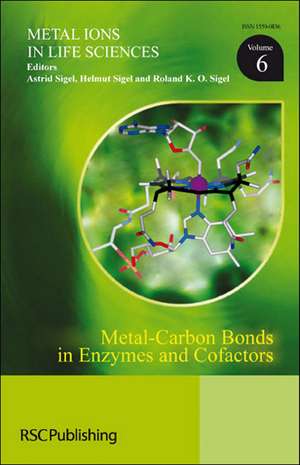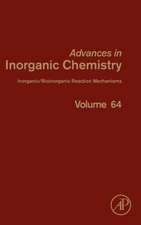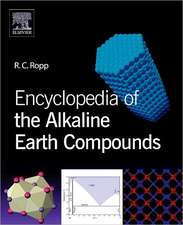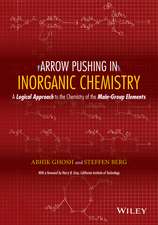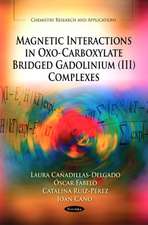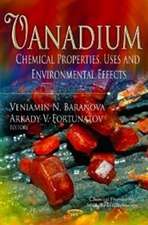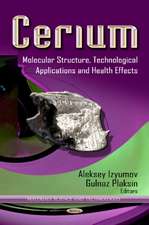Metal-Carbon Bonds in Enzymes and Cofactors: Metal Ions in Life Sciences, cartea 6
Editat de Astrid Sigel, Helmut Sigel, Roland K. O. Sigelen Limba Engleză Hardback – 8 mar 2009
There is no other comparable book. Metal-Carbon Bonds in Enzymes and Cofactors, Volume 6, written by 17 experts, summarizes the most recent insights into this fascinating topic.
| Toate formatele și edițiile | Preț | Express |
|---|---|---|
| Hardback (2) | 751.80 lei 6-8 săpt. | |
| De Gruyter – 31 dec 2008 | 751.80 lei 6-8 săpt. | |
| Royal Society Of Chemistry – 8 mar 2009 | 1021.67 lei 43-49 zile |
Din seria Metal Ions in Life Sciences
- 9%
 Preț: 3007.01 lei
Preț: 3007.01 lei - 18%
 Preț: 1215.67 lei
Preț: 1215.67 lei - 18%
 Preț: 1334.67 lei
Preț: 1334.67 lei - 18%
 Preț: 1250.39 lei
Preț: 1250.39 lei - 18%
 Preț: 1237.93 lei
Preț: 1237.93 lei - 18%
 Preț: 954.14 lei
Preț: 954.14 lei - 5%
 Preț: 1105.21 lei
Preț: 1105.21 lei - 24%
 Preț: 1095.87 lei
Preț: 1095.87 lei - 23%
 Preț: 1933.94 lei
Preț: 1933.94 lei - 23%
 Preț: 1932.47 lei
Preț: 1932.47 lei - 23%
 Preț: 752.39 lei
Preț: 752.39 lei - 23%
 Preț: 751.80 lei
Preț: 751.80 lei - 23%
 Preț: 755.22 lei
Preț: 755.22 lei - 23%
 Preț: 748.41 lei
Preț: 748.41 lei - 23%
 Preț: 746.93 lei
Preț: 746.93 lei - 32%
 Preț: 1274.65 lei
Preț: 1274.65 lei - 32%
 Preț: 1973.42 lei
Preț: 1973.42 lei - 27%
 Preț: 1375.96 lei
Preț: 1375.96 lei
Preț: 1021.67 lei
Preț vechi: 1122.71 lei
-9% Nou
Puncte Express: 1533
Preț estimativ în valută:
195.52€ • 212.31$ • 164.24£
195.52€ • 212.31$ • 164.24£
Carte tipărită la comandă
Livrare economică 24-30 aprilie
Preluare comenzi: 021 569.72.76
Specificații
ISBN-13: 9781847559159
ISBN-10: 1847559158
Pagini: 544
Dimensiuni: 156 x 234 x 34 mm
Ediția:2009
Editura: Royal Society Of Chemistry
Colecția Royal Society of Chemistry
Seria Metal Ions in Life Sciences
Locul publicării:Cambridge, United States
ISBN-10: 1847559158
Pagini: 544
Dimensiuni: 156 x 234 x 34 mm
Ediția:2009
Editura: Royal Society Of Chemistry
Colecția Royal Society of Chemistry
Seria Metal Ions in Life Sciences
Locul publicării:Cambridge, United States
Public țintă
Professional/practitionerDescriere
The occurrence of a wide variety of metal-carbon bonds in living organisms, ranging from bacteria to humans, is only recently recognized. Of course, the historical examples are the B12 coenzymes containing cobalt-carbon bonds, but now such bonds are also known for nickel, iron, copper, and other transition metal ions.
There is no other comparable book. Metal-Carbon Bonds in Enzymes and Cofactors, Volume 6, written by 17 experts, summarizes the most recent insights into this fascinating topic.
There is no other comparable book. Metal-Carbon Bonds in Enzymes and Cofactors, Volume 6, written by 17 experts, summarizes the most recent insights into this fascinating topic.
Cuprins
Organometallic chemistry of B12 coenzymes.- Cobalamin- and corrinoid-dependent enzymes.- Methyl-coenzyme M reductase: Ni-C bond formation.- Nickel-carbon bonds in ACS/CODH.- Structure and function of [NiFe]-hydrogenases.- Carbon monoxide and cyanide in [FeFe]-hydrogenases.- Carbon monoxide in the active site of [Fe]-hydrogenase.- Dual role of HEME regarding carbon monoxide.- Copper-carbon bonds.- Enzymes containing V, Mn, non-HEME Fe, and Zn.- Molybdenum hydroxylase xanthine oxidoreductase.- Computational studies of bioorganometallics.
Recenzii
Mainly coenzyme B12
Metal-carbon bonds in enzymes and cofactors
Series: Metal Ions in Life Sciences , Vol. 6
A. Sigel, H. Sigel and R.K.O Sigel (Eds)
RSC Publishing, Cambridge, UK, 2009, 544pp. (HB) ISBN 9781847559159
Reviewed by Kevin Waldron
This, the latest in the excellent Metal ions in life sciences series, focuses on biological molecules that contain a metal-carbon bond. The most familiar molecule of this class is coenzyme B12, whose structural determination in 1956 by Dorothy Hodgkin confirmed the presence of a cobalt-carbon bond. This was the first such example, arguably marking the beginning of the field of bio-organometallic chemistry and contributing to Hodgkin's achievements recognized with the Nobel prize for chemistry in 1964.
B12 remains well studied today, partly due to the fact that its biosynthesis is achieved only by microorganisms and that dietary deficiency results in pernicious anemia in humans. Indeed, such research is still revealing some molecular surprises, such as the relatively recent discovery of the B12-sensing riboswitch that regulates gene expression in response to available B12 concentration.
After dealing with the organometallic chemistry and enzymatic utilization of B12 in chapters one and two, this book concentrates primarily on the interaction of CO and CN- with metal ions. These latter ligands are usually regarded as solely toxic molecules, but perhaps surprisingly are physiological ligands to Fe and Ni ions in the active sites of hydrogenase enzymes, whereas CO is produced by the activities of metal-dependent enzymes such as haem oxygenase and acetyl coenzyme A synthase. They are also useful as spectroscopic tools to interrogate a range of metal binding sites for chemical and structural information in vitro, covered in later chapters.
As with all books of this series, the combination of cost and subject matter means that this book is predominantly intended as a primary resource for researchers working in the field, but will surely also prove useful for undergraduates as a gateway to the subject with its extensive reference list.
Chemistry World, 2009, 6(11), p. 65
Metal-carbon bonds in enzymes and cofactors
Series: Metal Ions in Life Sciences , Vol. 6
A. Sigel, H. Sigel and R.K.O Sigel (Eds)
RSC Publishing, Cambridge, UK, 2009, 544pp. (HB) ISBN 9781847559159
Reviewed by Kevin Waldron
This, the latest in the excellent Metal ions in life sciences series, focuses on biological molecules that contain a metal-carbon bond. The most familiar molecule of this class is coenzyme B12, whose structural determination in 1956 by Dorothy Hodgkin confirmed the presence of a cobalt-carbon bond. This was the first such example, arguably marking the beginning of the field of bio-organometallic chemistry and contributing to Hodgkin's achievements recognized with the Nobel prize for chemistry in 1964.
B12 remains well studied today, partly due to the fact that its biosynthesis is achieved only by microorganisms and that dietary deficiency results in pernicious anemia in humans. Indeed, such research is still revealing some molecular surprises, such as the relatively recent discovery of the B12-sensing riboswitch that regulates gene expression in response to available B12 concentration.
After dealing with the organometallic chemistry and enzymatic utilization of B12 in chapters one and two, this book concentrates primarily on the interaction of CO and CN- with metal ions. These latter ligands are usually regarded as solely toxic molecules, but perhaps surprisingly are physiological ligands to Fe and Ni ions in the active sites of hydrogenase enzymes, whereas CO is produced by the activities of metal-dependent enzymes such as haem oxygenase and acetyl coenzyme A synthase. They are also useful as spectroscopic tools to interrogate a range of metal binding sites for chemical and structural information in vitro, covered in later chapters.
As with all books of this series, the combination of cost and subject matter means that this book is predominantly intended as a primary resource for researchers working in the field, but will surely also prove useful for undergraduates as a gateway to the subject with its extensive reference list.
Chemistry World, 2009, 6(11), p. 65
Caracteristici
The books appearing in the series uniquely link coordination chemistry and biochemistry in their widest sense
Notă biografică
Helmut und Astrid Sigel, University of Basel, Switzerland. Roland K. O. Sigel, University of Zürich, Switzerland.
